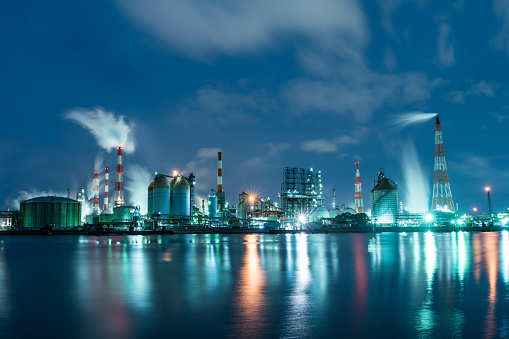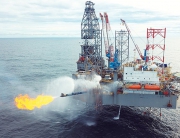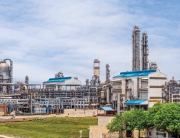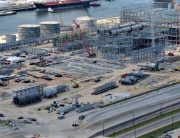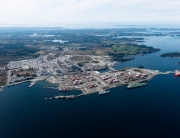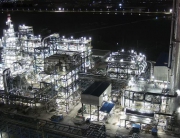HPCL Rajasthan Refinery Ltd. (HRRL), a 74-26% joint venture of Hindustan Petroleum Corp. Ltd. (HPCL) and the state government of Rajasthan, has let a contract to ABB Power Products and Systems India Ltd. (Hitachi ABB Power Grids) to provide associated power infrastructure for the JV’s proposed 181,000-b/d integrated refinery and petrochemical complex now under construction at Pachpadra Tehsil, Barmer District, Rajasthan.
As part of the Oct. 8 contract—valued at more than 1-billion rupees—Hitachi ABB Power Grids will supply a 220/66-kv substation with gas-insulated switchgear to assimilate power from the state grid and deliver it smoothly and efficiently to the new refinery to ensure the complex has a reliable power source and avoid potential supply disruptions, the service provider said.
To maximize power availability, Hitachi ABB Power Grids said it will equip the substation with advanced substation automation systems to control and protect HRRL’s grid, as well as deploy power transformers to further enhance power infrastructure safety and efficiency.
This latest contract follows the JV’s previous award to Chevron Lummus Global LLC (CLG)—a partnership of Chevron USA Inc. and Lummus Technology LLC—to deliver licensing and extended basic engineering design of a 48,200-b/d delayed coking plant at the complex based on CLG’s proprietary delayed coking technology.
HRRL also previously let a contract to McDermott for license and basic engineering design of two 420,000-tonne/year polypropylene units that will use Lummus’ proprietary Novolen process reactors and proprietary NHP catalyst to produce a full range of polypropylene products at the new refinery.
Project progress, overview
On Aug. 24, HPCL said engineering and procurement activities for HRRL’s greenfield refinery were progressing well, with site grading and construction of the boundary wall, major internal roads, power utility installations, and a water reservoir already completed. Construction of unidentified major process units, utility plants, an approach road, and fabrication of major long lead items also are now under way, according to HPCL.
Once completed, the refinery—which will take about 4 years to build—will be equipped to produce Bharat Stage 6-grade fuels (equivalent to Euro 6-quality) from a feedstock of both locally produced and Saudi Arabian crudes to meet increased demand for petroleum products in Rajasthan as well as other northern Indian states.
During its first 8 years of operation, the refinery will be designed to process 1.5 million tpy of Rajasthan crude from nearby Mangla fields and 7.5 million tpy of imported Arab Mix crude—consisting of Arab Light and Arab Heavy grades—before switching to a full 9 million-tpy feedstock slate of Arab Mix beginning in its ninth year of operation, according to documents filed with India’s Ministry of Environment, Forest, and Climate Change (MOEFCC).
According to Engineers India Ltd.’s revised environmental impact assessment for the Barmer project filed with MOEFCC in July 2017, the complex will include the following nameplate processing capacities:
- Crude distillation, 181,000 b/d.
- Vacuum distillation, 96,400 b/d.
- Naphtha hydrotreating, 36,100 b/d.
- Isomerization, 5,200 b/d.
- Continuous catalyst regeneration reforming, 6,000 b/d.
- Diesel hydrotreating, 82,300 b/d.
- Fluid catalytic cracking, 58,200 b/d.
- Delayed coking, 48,200 b/d.
- Polypropylene (two units), 490,000 tpy each
- Butene-1, 59,000 tpy.
- Linear low-density/high-density polyethylene (two swing units), 416,000 tpy each.
- Vacuum gas oil hydrotreating, 70,300 tpy.
- Dual-feed steam cracking, 820,000 tpy.
- Low-pressure ethylene recovery, 77,000 tpy.
- Benzene recovery, 96,000 tpy.
- Pyrolysis gasoline hydrotreating, 11,000 b/d.
- BTX fractionation, 11,000 b/d.
- FCC gasoline depantanizing, 17,500 b/d.
- Gasoline hydrotreating, 10,600 b/d.
- FCC C5 Merox, 4,400 b/d.
- Saturated LPG Merox, 3,300 b/d.
- LPG depropanizing, 3,300 b/d.
- Fuel gas treating, 1,425 tonnes/day.
- Hydrogen generation, 37,000 tpy
- Pressure-swing adsorption, 28,000 tpy.
- Sour-water stripping (hydroprocessing), 100 cu m/hr.
- Sour-water stripping (nonhydroprocessing), 250 cu m/hr.
- Amine regeneration (three units), 480 cu m/hr each.
- Sulfur recovery with tail-gas treatment (two units), 199 tonnes/day each.
Source: www.ogj.com


